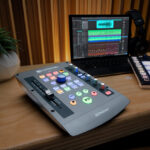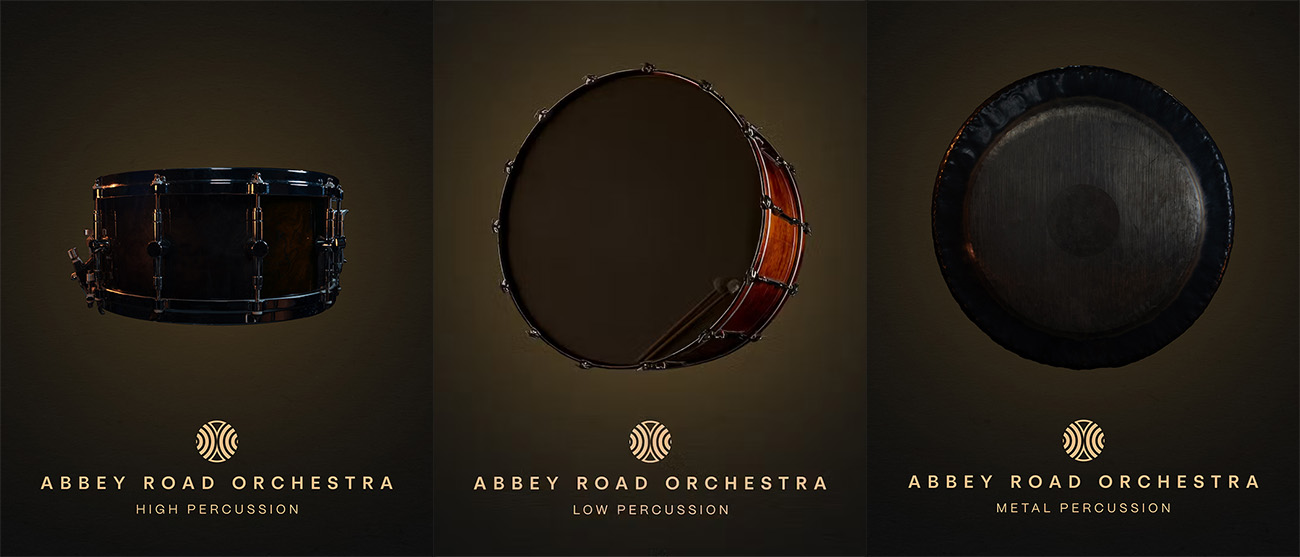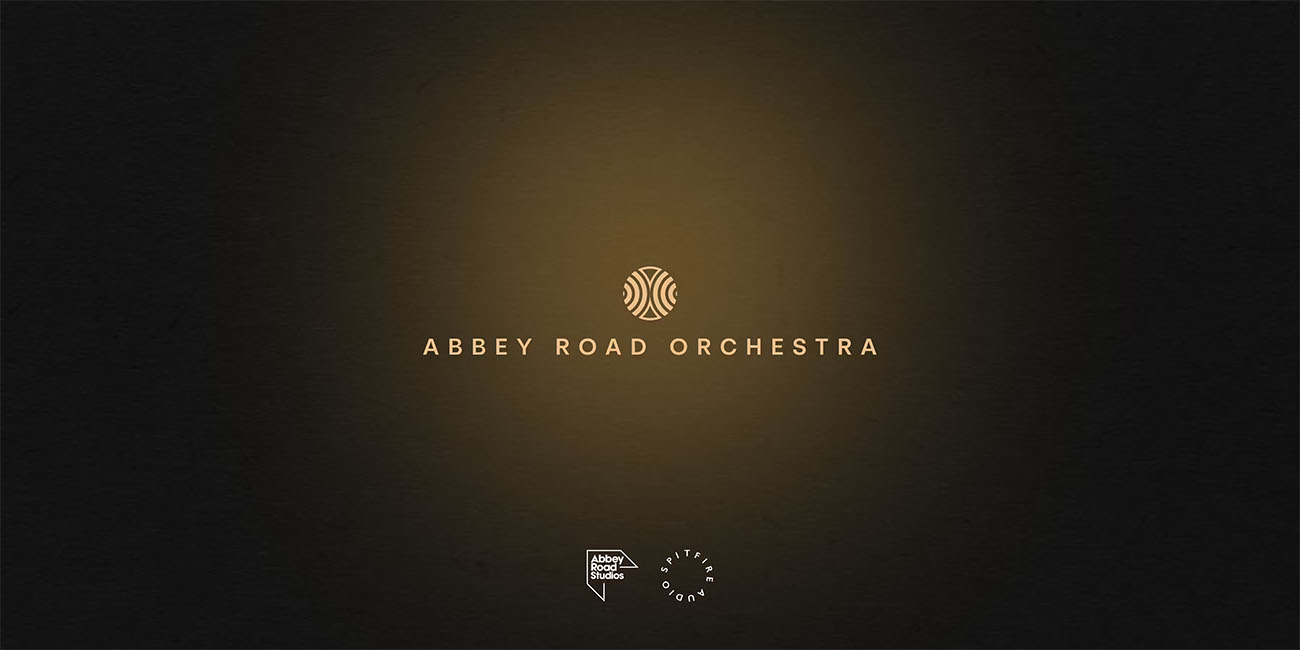Abbey Road Orchestra Low, High and Metal Percussion Review
These initial three Abbey Road Orchestra modules are an excellent launching point for an extremely ambitious project. The level of detail is unmatched, and the sound is pristine. If you can put aside the cost, these modules are the best orchestral percussion libraries available right now.
(Not an affiliate link)
What we like
What’s not to like
What you should know
Developer:
Spitfire Audio
Price:
$449 for each module
The Abbey Road Orchestra is a modular orchestral library that is still in it’s relative infancy, but we have the first three modules in hand and ready to put through their paces. The Low Percussion, High Percussion, and Metal Percussion portions of Abbey Road Orchestra have the distinct honor of going first.
We spent a lot of time in the first part of our coverage on the Abbey Road Orchestra going over the apparent philosophies behind the project, the interface, pricing, and much more. If you need a refresher, you can find that article by clicking here.
In this part of the review, we’re going to jump into the actual percussion modules themselves. We’ve chosen to review all three at once because there is a lot of overlap in features and the way things are organized. Who knows how future modules will be covered. I’m kind of winging it here…..
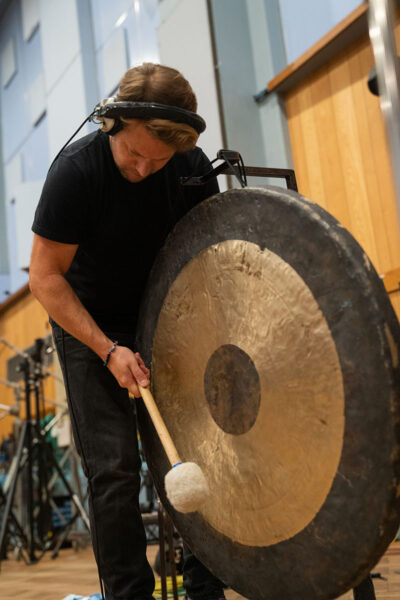
Introducing the Abbey Road Percussion Modules
The first three modules in the Abbey Road Orchestra are Low Percussion, High Percussion, and Metal Percussion. The three of these essentially combine into a mostly full orchestral percussion library. But I should note up front that these are unpitched instruments. My assumption is that a dedicated timpani module and others like tubular bells will come at some point, and possibly others. So it’s hard to say how complete this is. But what’s included is all the unpitched variety you could want, and it’s massive.
Starting with percussion was an interesting choice for the Abbey Road Orchestra. Spitfire likely wanted to get some modules released that could create a little buzz, while also giving them extra time to fine-tune some of the more intricate libraries like strings and brass. I was a little skeptical at first, but that skepticism was quickly removed when I got the chance to play with the percussion. You’ll see in this review that these modules are fully worthy of representing Abbey Road Orchestra while we wait for the rest. With the 1st Violins right around the corner, we’ll finally get to see more of what to expect going forward. But so far, the percussion has done it’s job.
You’re going to need a good chunk of hard drive space for the Abbey Road Orchestra. These three modules utilize a whopping 306GB on Windows thanks to the number of mic positions and the level of detail in each module. Thankfully, hard drives are more affordable than ever. But definitely consider dedicating one to this library by itself. If you plan to get it all, you may need multiple drives. Unfortunately at this time, the Spitfire Audio app does not allow you to choose which mic positions you want to download. It’s all or nothing.
So what’s included? I’m glad you asked. Let’s get to the gritty, shall we?
The Instruments of Abbey Road Orchestra Percussion…So Far
I want to be careful not to just make this review into a reproduction of the product pages. However, being that this review is covering three volumes, I do want to run down the list of instruments you can expect in each one. Keep in mind that these are just the high level instrument listings. There is a lot of detail contained within, which we’ll get into momentarily.
Low Percussion
Disk Space: Approx. 89GB
High Percussion
Disk Space: Approx. 92GB
Metal Percussion
Disk Space: Approx. 126GB
One thing I really appreciated right away is the approach of “give them all of it” in Abbey Road Orchestra. You will find a literal full selection of percussion instruments here, but as you may notice above, you also get certain variations that aren’t as common. A few less-traditional instruments are included, and I really appreciate the collection. And we haven’t discussed the playing techniques and striking methods that add a huge amount of variety. More on that shortly.
There is a little overlap in terms of what is considered “low” and “high” as well. Some people might place the Darbuka in the low percussion, for instance. So the breakdown above will also help to see exactly what is placed where. In the end, some distinctions are tricky.
Obviously, a keen eye will probably notice an instrument or two that are missing. There is always somebody who says “I’m a fan of this obscure instrument and they didn’t include it”. But overall, this is a fairly complete set of standard orchestral percussion and a few extras that will satisfy the vast majority of composers.
Detailed Sound For Simple Instruments
I’ll be honest (I sure do say that a lot, don’t I?); orchestral percussion, while fun to use and essential to a good score, isn’t exactly the most exciting topic to write about. Most percussion instruments don’t have the nuance and articulation breadth that other sections might have. Most percussion, by definition, are just single hits that ring out in a number of ways.
But that aside, Spitfire has managed to create about as much color as is possible from the instruments being sampled by focusing on detail, maybe even too much detail at times. The term “deep” sampling gets thrown around, but it absolutely applies here.
There are four areas where I feel these libraries excel, and these apply to all three percussion modules:
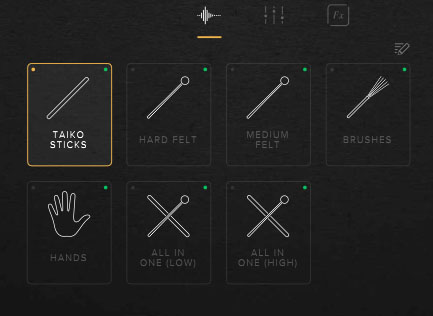
Playing Techniques and Beater Types– In lieu of typical articulations, Spitfire provides different materials to strike the instrument with. Many instruments have 6 or 7 different beaters to choose from. For instance, hard and felt beaters, sticks, brushes, hands, etc.- This essentially provides you with all the sound variation needed from most of the included instruments. So while you may have 20-30 instruments in a module, you have hundreds of different sound variations available out of the box.
Round Robins– Percussion instruments, more than any other, benefit from having multiple round robins, and the Abbey Road Percussion instruments have these in droves. Most instruments contain between 12 and 16 round robins per hit (you can adjust how many are loaded if RAM usage is a problem). I’m not sure if that’s the most ever of any library, but it has to be close. But when you consider that many of these instruments have up to 10 velocity layers, 16 different microphone options, multiple beater types, and several ways of striking each instrument, the logistics start to get a little insane.
Different ways of striking instruments– Center hits, rim shots, palm strikes, and more are included for most instruments in these modules. You’ll see instruments that have body hits included even if it isn’t standard, or maybe the instrument is scraped or bowed when it normally isn’t. While these libraries focus mostly on the traditional, Spitfire has included about as many ways to play each instrument as possible.
Microphones and positions– There are a total of 16 different microphone positions included for each instrument. 2 of these are custom pre-mixed signals that are fairly ‘production-ready’, while the remaining 14 are made up of everything from close mics to deca trees, ambient mics, and more. You also get a few signature microphone signals from classic microphones used on countless popular recordings. Abbey Road Studios is known for it’s superb and well-tuned mic closet, and you benefit from this in Abbey Road Orchestra.

What you end up with is a library chock full of ‘extra’. And this goes in line with what the Abbey Road Orchestra was marketed to be. It’s a kitchen sink library in a way. As mentioned above, these instruments also have as much as 10 velocity layers as well (according to their website, though I haven’t counted myself, lol). It’s an incredible amount of detail, more than I recall ever seeing in a library before.
The amazing thing to me is how clean they have managed to keep everything. Most large orchestral libraries will end up with a few bum notes, pencils being dropped by the player, faint coughs in the background, etc. And this may end up being the case with future modules in this library. But I can’t say that I heard a single things that was off during my time so far with Abbey Road Orchestra Percussion. Well done.
A quick note on sound quality- I’m lovin’ it
You’re going to see me make a lot of mentions throughout this review (already have, and trust me, there’s more to come below) about how great the Abbey Road Orchestra’s percussion modules sound. In an attempt to not get caught up in cheesy and repetitive hyperbole, I don’t want to spend extra paragraphs gushing over the whole thing.
But I do want to say that in a sample library, sound quality is one of the most important features (right up there with playability, in my book). And it’s obvious that getting the perfect sound was on top of mind for the team at Spitfire. Using a Senior Engineer at Abbey Road Studios (Simon Rhodes) and a renowned percussionist who is intimately familiar with Abbey Road (Joby Burgess), along with instrumentalists who are experienced with playing at Abbey Road, it just adds up to what can only be described as excellence. This isn’t a team of people trying to recreate what makes Abbey Road special. These are some of the people who have MADE Abbey Road special.
Now, the color of the sound may or may not be your cup of tea. No single library can fill every need or every piece or style. But the quality of recordings, it’s hard to argue about. They are REALLY good.
The size of Abbey Road Studio One makes for a fairly large sound, and Abbey Road Orchestra Percussion can be really large. I wouldn’t go so far to call it an “epic percussion” library, but it’s big. You can really push the ambience in the higher velocities. But with all the space that is present in the sound, there is virtually no loss of detail. You still get an intimate closeness in most instruments. The strike of each instrument is just as clear as the resonance. It’s really well done in this area. Bringing up the close mics allows you to tame down the room a bit if you need. But you can’t get a completely dry sound with these mics. The signature of Abbey Road is still there.
Speaking of mics, there are loads of them. And they all capture something unique. 16 different mic options, which includes two pre-made mixes, are present. The included mics are:
There are plenty of options here for how you place instruments in the Abbey Road space. But you can really fine-tune the sound by mixing together specific mics precisely to get the right amount of room and character. Just be careful of your RAM usage. Using multiple mics quickly uses up that memory.
Another key point I kept thinking is “these sound like the demos”. Very rarely does a library sound like the demos out of the box. The Abbey Road Orchestra percussion modules do. I’m not suggesting you won’t need any mixing or mastering when using them. But the sound is so carefully crafted that you’re getting a recording that is ready to go. And it all fits together so well.
You’ll find that Abbey Road Orchestra’s percussion modules have a special air about them. There is a synergy between the instruments and the space that just feels natural. Clear and detailed recordings of instruments that just feel alive. And that’s the best way I can explain it.
Playing Abbey Road Orchestra Percussion
Being a percussion library, these modules are not particularly on the difficult side in terms of playability. So if you’ve played percussion on the keyboard before, or programmed a percussion piano roll, this library will bring virtually no learning curve. But there are a few things worth mentioning.
Most instruments have multiple hit types (left/right hit, rim shot, slap, roll, etc., based on each instrument). Loading an instrument gives you these options mapped chromatically using octaves to divide. For instruments with multiple sizes or types (like cymbals with different sizes available), each size or type will begin in a new octave. Nothing groundbreaking, but easy to understand. So in the below example (from the initial suspended cymbals patch), there are three different cymbals, each one starting a new octave (starting on C, but you can change this easily in the player)

One thing I do enjoy is the ability to turn on a “two handed” mode, which duplicates the entire layout a second time, higher up on the keyboard. This allows you to “play” each instrument with two hands spread apart, which kind of emulates two-handed percussion playing. But it’s extremely helpful and practical to play this way instead of having to rely on left and right hand hits right next to each other. Using this mode doesn’t change the mapping. It just duplicates it further up the keyboard.
Another feature that I found myself using a lot, and probably my favorite playability feature, is the ability to control the dynamics of things like rolls or suspended cymbals using the mod wheel. I love how smooth the results are and how easy it is to shape your rolls using true velocity layer morphing (my words, not theirs- just how I best describe it). Considering how many layers and variations these instruments have, it would be easy to get lazy with this programming. Nope. It’s very smooth. Now, if you wish, you can turn off the mod wheel control of dynamics and control them using velocity, but I don’t know why you would. You’ll use this feature. It’s done very well.
There are more features here, but I’m going to leave it there for now. I found that most of what I wanted to do was fairly simple. Several playability features will come in handy more once non-percussion libraries are released. But for these three modules, it’s fairly straightforward.
Abbey Road Low Percussion- A Breakdown of the Bottom
NOTE: As I get into each module, I want to be clear that I’m not going to give thoughts on every instrument. I can’t possibly cover every beater type and every playing technique of every instrument. Heaven knows this review is already long enough. But I’m going to focus on more general thoughts, and a few things that I feel stand out to me. Please see the instrument lists above for a full breakdown of what you will find.
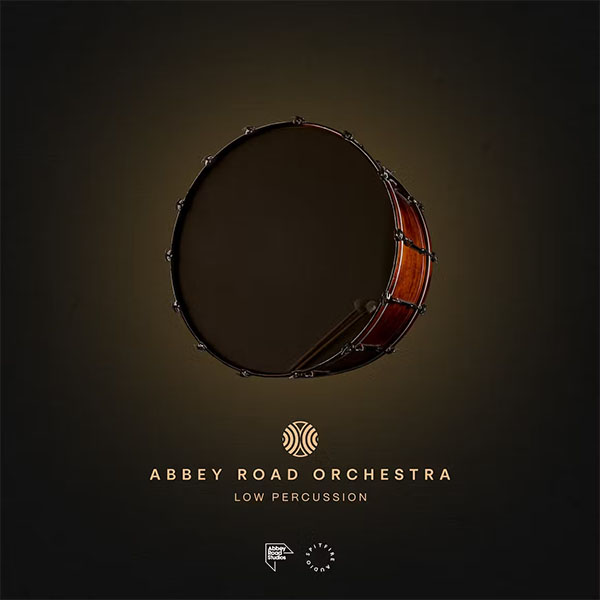
Low percussion is one of the ways that an orchestral score can add a lot more ‘meat’ for the bones. It’s like the bass guitar of the orchestra. Bass frequencies tend to fill the void in a score. The low boomy drums of war to the symphonic crescendo of a bass drum, it’s all designed to complement the intended mood. They can also become a problem if you aren’t careful. It truly is an art trying to find sounds that fill without masking other instruments.
If you read the first part of our coverage, you will probably already know that the people involved with the recording of this project really know what they are doing. And the quality of recordings in Low Percussion show that. I feel like more attention was given to creating a sound that was alive, instead of just making a sound that was “big”. I mean, the sound IS big. But I would describe it more as a “round” big than a “boomy” big (these are the scientific terms, of course), and the room provides the extra thickness.
One thing I always watch out for in lower frequency libraries is frequency buildup. Playing one hit or note might sound fine, but playing successive notes can quickly overpower. Sometimes this can be due to rumbles in the floor or overtones from improperly treated spaces or instruments tuned incorrectly. But I found virtually no issues with the Low Percussion in Abbey Road Orchestra. It’s surprisingly clean.
The number of instruments in Low Percussion is less than that of the other two modules, but I would argue that the character level is the highest of the bunch. I believe this is due to how well Abbey Road Studio One handles bass reflections. Even the close mics get a healthy amount of ambience around them, which can also be a bad thing if you are wanting a completely dry sound. But without this ambience, the instruments would lose some shine. So I’m a fan of it.
The variety of instruments in the Low Percussion module is very nice, at least considering that most low percussion is created using the same physics and materials. Glancing at the instrument list, you may notice a total of no less than 4 bass drums. Yet, there is a different character for each one. The standard bass drum comes with a snappy impact and a more full bottom end, while the alt bass drum brings a more woody resonance, and the gong bass drum comes somewhere in between. But the snap of a Puili stick on the gong drum brings a whole new sound signature to the drum, while brushes on the standard drum gives you an almost entirely different instrument.
It’s all very complementary.
Probably my favorite instrument in Low Percussion are the Taikos. Then again, one of my favorite percussion instruments in general is the Taiko. You get three in total here, including a massive 60″ version. I love the Taiko because it tends to have a unique sense of motion when being played properly. A properly played Taiko isn’t played standing still…motion causes emotion, right?
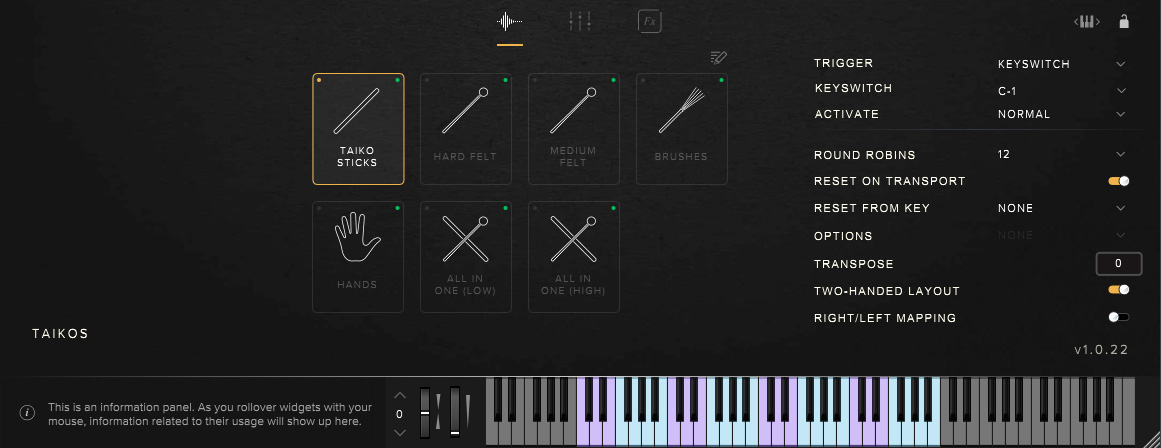
I found myself just banging out random rhythms using whatever my fingers would hit, and I couldn’t get the Taikos to sound unnatural. They really shined (shone?) here. And the brushed Taikos were a fun change from the norm, bringing a more subdued undertone while still feeling active.
There is a lot to like here, from a full selection of resonant toms to the bouncy sound of the Dragon Drum. All the boom, none of the mush.
I really enjoy playing this module. I’m a piano player with questionable natural percussion rhythm. But this module is where I will start with all the eclectic rhythmic ideas in my head. And it just sounds good every time.
Abbey Road High Percussion- The Harmony of the Percussion

While low percussion is a great filler that helps to ooze sound into the crevices of a score, the high percussion instruments give it life and movement. The high percussion is meant to break through the mix of standard orchestral scores. Often featured by themselves in a somewhat ‘solo’ nature, these instruments don’t just sit in the background. They sit in the foreground. From drumlines to comedic knocks to tribal beats, high percussion instruments are meant to be heard more than they are felt.
The challenge is often in the tuning of each instrument, as these instruments tend to have a more definable resonance. This can sometimes come across as “pitched”, even though they aren’t designed this way. Improper tuning of high percussion can really start to irritate the listener.
Abbey Road Orchestra High Percussion is probably the module with the most variety of sound, at least in terms of standard hits (Metal Percussion has a few instruments that stray from the standard hit formula). The instruments here are all membrane or wood-based instruments with less ring-out than their lower percussion brethren, making these instruments ideal for faster rhythms. But this doesn’t mean they contain less character or power.
The first place I always look in libraries like this are the snares. If you can feel the velocity of the snares, you’re off to a good start. The snare selection in High Percussion is a nice variety, and I found them to be quite active. Even though there are two 15″ snares (standard snare and field drum), the different body materials make them sound nothing alike. The field drum has this awesome resonant low end that would be right in place on the battlefield, while the standard snare and two piccolo snares create some amazing drumline sounds straight from your local college fight song.
The snares also feature the ability to play with the drum snares on or off, which is something a surprising amount of libraries don’t include. But it’s here.
Of all the modules covered here, the High Percussion is the one that benefits the most from the included rolls and swells. Nearly every drum in this module has rolls included, and the smooth transition between the rolls and standard hits is just so fun. While low percussion instruments are easy to play rolls by hand (they tend to be slower rolls with less attack), these instruments really sound bad if you aren’t disciplined in your timing. But thankfully, the mod wheel control over dynamics in the rolls left me smiling.
Speaking of dynamics, to my ears, the dynamics of the snare rolls here are deeper than any previous library I’ve owned. I can’t get over how well it comes out every time.
The roto toms are another standout for me. They include a full set, both with sticks and brushes, and plenty of play style. They work perfectly layered with some Taiko rhythms in fast moving context, while also being able to pull off a pretty convincing Phil Collins-style riff. Or maybe…..all of the above at once….
The ethnic percussion (congas, bongos, djembe, darbuka) in Abbey Road Orchestra High Percussion is probably the low point for me, but not because it’s bad. It’s just a small notch below the other instruments in terms of liveliness and thickness. I did find I needed to pull up the volume output of these instruments compared to the others in this module. But don’t misunderstand. They are still a lot of fun. Not every instrument can be a favorite though, right? One instrument that did impress me though in this area is the Shime Daiko. The rounded attack and reverberance of the instrument really gave me a different feel, and while not the most common instrument in orchestral libraries, it stands out here.
Rounding out this module is a full selection of shaker-style instruments, wood blocks, and a few higher character instruments like the log drum and temple blocks. The shakers are fairly standard, but fit perfectly in the room, while the smaller wooden instruments bring a little extra personality to the accents in a score. I found that with these, the attacks really bite through into the Abbey Road room sound, giving them more life than I would expect from smaller instruments.
Abbey Road Metal Percussion- Quite the Character Builder
(Ok, I know the headlines are getting a little cheesy. Let me have my fun. My fingers are getting tired…)
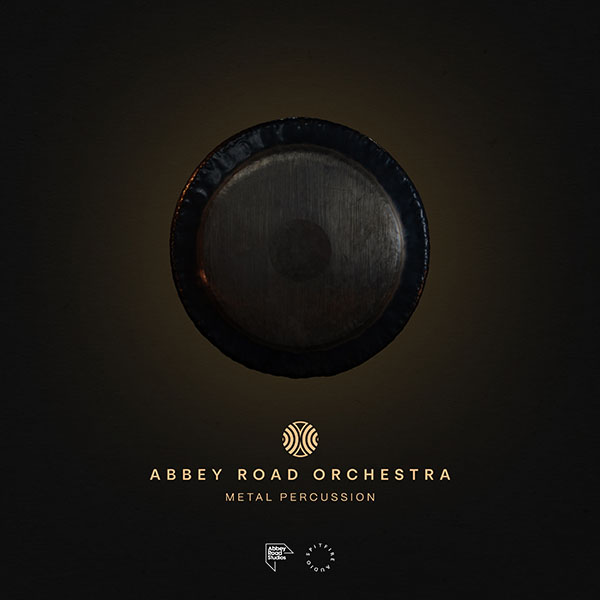
You’ve got filler. You’ve got movement. Now it’s time to add a little shine. Metal percussion instruments tend to be the ones that add special emphasis to your score. They provide a little extra detail when needed (like the mighty triangle), while at times completely taking center stage (crash cymbals, for instance).
Metal percussion is a difficult beast to slay sometimes. You’re dealing with more resonant frequencies, ringing of the room, signal clipping, and more frustrating issues. When you start to implement so many velocities and round robins and playing styles, it’s complicated. So getting the metal stuff right is very important, and I fully expected to be underwhelmed by this library. But as with the other two libraries above, the issues that can arise simply weren’t an issue with the Metal Percussion module. And I’m happy that my expectations were wrong.
The number of instruments in Abbey Road Metal Percussion is quite high, as is the disk space required. Including more than any other module being discussed here, I was pleasantly surprised with this offering.
The standard fare here is the cymbal selection. If you can’t get the cymbals right, you might as well close up shop. But not only did Spitfire get these right, they knocked it out of the park. From handheld crash cymbals to the “small gong-like” China cymbal, you have about every kind of option needed in a typical orchestral score. From the whispy spiral cymbal that almost feels like it’s angry at you, to the lighter splash cymbals, to full-sized thundersheets, I believe every sonic color is included.
The only issue I found, and it’s in only a very small number of instruments, is that on some higher velocities, you would occasionally hear the resonance of either the floor or a nearby music stand, or similar. It wasn’t particularly distracting when placed in a mix. And it isn’t even necessarily unnatural. I mean, if you watch a live orchestra, you are hearing resonances of all kinds that you don’t even know are there. But it’s worth mentioning at least.
My absolute favorite part of this module is the suspended cymbals. These are the most sonically diverse instruments here, and they include some amazing swells and rolls. These are once again controlled by the mod wheel and come out as buttery smooth in their transitions. I’ve traditionally used libraries with a few preset lengths of swells and rolls included, and it just feels so clunky going back to those now. You also get choked varieties of these swells.
The suspended cymbals even have a few extra goodies thrown in though. In addition to standard stick hits and brushes and mallets, you also get scratched and bowed playing styles. These give you a very unique, somewhat haunting accent sound that is also very ambient.
In addition to the more traditional instruments, Abbey Road Orchestra Metal Percussion also includes more obscure and manufactured instruments than the other libraries. Things like oil drums and trash cans to scaffolding, and even actual automobile brake drums (how many orchestral performances have you been to where they were playing brake drums?) are included. I feel like they probably came to this recording and said “let’s throw in the kitchen sink”, and when they couldn’t get the sink loose, they pulled their car in the garage and played that instead.
All kidding aside, there is so much sonic variety in this module. And I haven’t even talked about the small traditional percussion instruments. Two different sleigh bells, three tambourines, a mark tree with really flexible continuous gestures and variable start points for glissandos, and no less than THREE cowbells complete with both side and top hits, and more.
Summing up the three modules
I realize that I’ve kind of skimmed through a lot of instruments, but it’s impossible to truly cover it all. The instruments included in the Low, High, and Metal Percussion modules are near-exhaustive when it comes to traditional sounding percussion. And there really aren’t many low points. These libraries are obviously a labor of love.
I’m sure that there will be some who accuse me of being a fanboy, shilling, or whatever. But I can’t emphasize enough how detailed these libraries are. They are special libraries with a cohesive sound, lots of options for tweaking, and are fine-tuned to represent the space they are recorded in.
Now, are they perfect? Absolutely not. Are they for everyone? Even moreso, absolutely not. There are even some who don’t like the Abbey Road Studios sound. And that’s ok. But what these modules do is accomplish exactly what they set out to do. And that is to be an exhaustive and detailed library that faithfully captures the life and feel of Abbey Road Studios. It’s a high bar, but I believe they have hit it….SO FAR. I can only speak for the percussion at this point.
The final word I’ll give on this is that no, you aren’t going to get the same results with this library as you would if you were hearing a live orchestra inside of Abbey Road Studios. These are still static samples played in a controlled sequence. But the amount of detail in them, mixed with the talent involved in the process, means this is as close as you can get to recording a percussion section inside Abbey Road Studios without actually being there yourself.
Adding effects, though limited they might be
Before we go, I want to run through one last area of tweakability; effects. There really aren’t a lot of options in terms of effects in Abbey Road Orchestra. The point here isn’t really to be a sound design tool, but rather a realistic orchestra inside an outstanding space. But there are a couple of things you can adjust.
The first is reverb. Spitfire has included actual impulse responses from Abbey Road Studios built into the plugin. This is helpful if you want a little more control over the room sound, or if you like one of the closer mics but need a little more ambience. I find myself typically ignoring the reverb because the microphone options sounded so good out of the box. And combining different mic positions really gives more flexibility than a one-knob reverb amount. So it’s nice to have, but limited use.
Another “effect”, though not really an effect at all, is the tightness knob. Honestly, this didn’t do enough for me to care much. The purpose is to essentially shorten percussion hits, particularly those of the shorter variety. Things like choked hits that are designed to cut off the natural sustain already, are further shortened by this knob. But in practice, it really only helps to remove some of the reverberation in the natural room sound. So if you like the room sound but want to cut a bit of the space off the end, this knob sometimes helped. I mostly never touch it.
Finally, on some patches you will find a “Releases” knob. This is meant for longer, more continuous hits like scratched cymbals or similar, where the sound is designed to ring out but you might want it to ring out a little more after you release the note. As with the other ‘effects’, this is very subtle. We’re not talking about the ability to turn these sounds into drones. It’s just some minor control.
I didn’t really come in expecting there to be much in terms of effects on these libraries. What’s there is useful in certain situations, but I rarely ever found myself wanting to adjust the sound with them. I don’t think the library really needs it most of the time. Still, can’t argue with their inclusion. More options is typically better, right?
So what’s the verdict, and should you buy Abbey Road Percussion?
I’m going to say first that I think Abbey Road Orchestra Percussion (all three currently available volumes) is spectacular in what it provides, and even better in how it sounds. I would even dare say that I’ve never enjoyed a percussion library more. It’s special. I’ve never heard a percussion library that has so much clarity, but also so much “alive” in it. This is truly a flagship sound.
Due to the sheer number of microphone positions, Abbey Road Orchestra Percussion can potentially mix well with most other libraries. It never seemed out of place when using it in a score. I even worked it into a mix using sounds from NotePerformer in Dorico, and it added liveliness that usually is harder to achieve in notation. So even though the rest of the library is still not available, if you need great percussion, these modules certainly fit that bill.
Determining whether you should buy is really not my job though, nor my goal. Only you can decide that. We have discussed the price already, which may instantly be a determining factor. But if you can afford it (or wish to go the “buy as you can” route), and you are in need (or want) of a true all-in-one detailed library recorded in one of the greatest studio spaces in the world, it can be worth every penny. It may even be your best purchase you’ve ever made. The library is that good. But it’s not an easy pill to swallow if the cost is an issue.
The problem I face when offering this advice, and the problem many people will face when deciding whether to buy, is that we don’t yet know exactly how the rest of the library will go. Percussion, in my humble opinion, is the “easy” part. But we don’t know how many volumes will make up the rest of the library, how they will sound, etc. What we do know is that the attention to detail in these first three volumes, combined with the sound quality and overall production quality, is probably greater than any library I’ve seen.
As great as it is, no library is essential. It’s important to realize that knowing your samples is better than having a better library. I always encourage people to not just buy the next big, shiny object they see. No library is going to make you a better composer. So consider your needs first. Then determine whether these initial modules will fit those needs. Abbey Road Percussion is, so far, outstanding. But
At the time of publishing, the Abbey Road Orchestra 1st Violins has just been announced and is a couple of days from release. And we’ll be covering that library in full detail as soon as we get our hands on it. I think that will give us a good idea of what to expect as the overall library progresses.
Watch this space.

